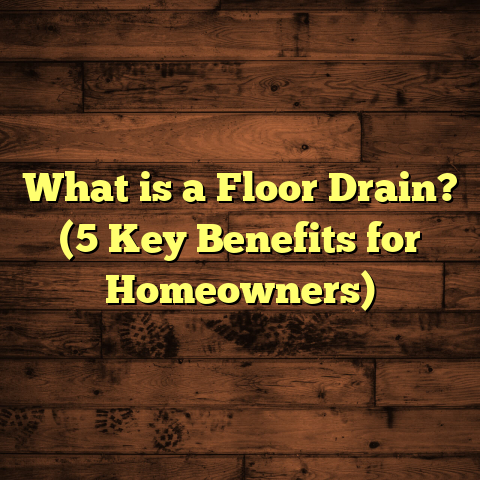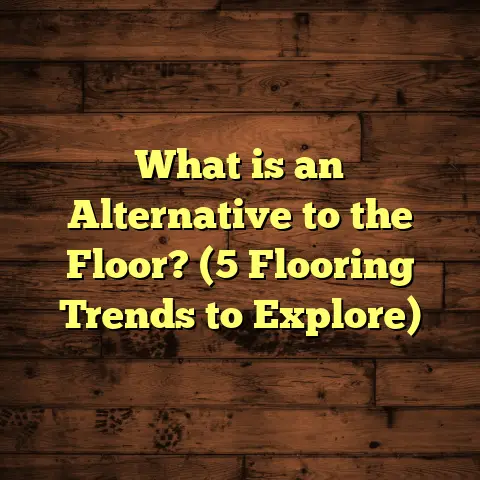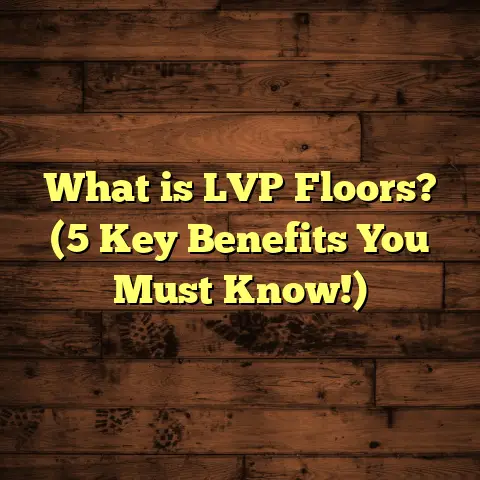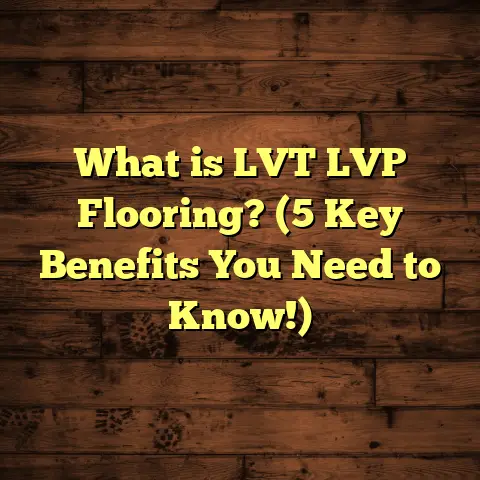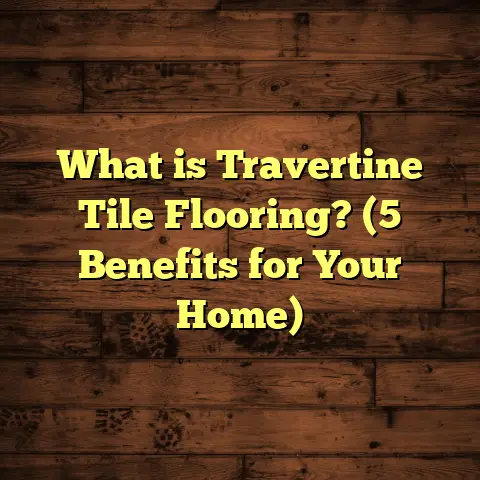What is the cheapest, easiest floor to install? (7 Budget-Friendly Options)
I remember the first time I faced a worn-out floor that needed replacing but had almost no budget or time to spare. That was a real dilemma—how do you get a fresh, good-looking floor without spending a fortune and without hiring expensive pros? If you’ve ever been in that spot, you know how tricky it can be. I’ve been there plenty of times, so I dug deep into the options that balance affordability, ease of installation, and decent durability. In this article, I’ll share what I’ve learned about the cheapest and easiest floors to install, based on personal experience, research, and case studies from real projects.
What Is the Cheapest, Easiest Floor to Install?
When people ask me this question, they usually want a floor that meets three main criteria:
- Low material cost — It can’t break the bank upfront.
- Simple installation — Ideally DIY-friendly with minimal tools or expertise.
- Decent durability and maintenance — It should last long enough to justify the effort.
Some floors check all the boxes better than others. The key is understanding how these materials behave in different spaces and what trade-offs you might need to accept.
I’ve worked on flooring projects ranging from rental flips, budget home renovations, to workshops and even art studios. Along the way, I’ve tested out various budget-friendly flooring options and helped others figure out what fits their needs.
Here’s an in-depth look at seven flooring types I keep recommending when affordability and ease of installation are top priorities.
1. Vinyl Sheet Flooring: Affordable Flexibility
Vinyl sheet flooring has been one of my go-to choices for quick renovations where budgets are tight but durability matters.
What Makes Vinyl Sheet Flooring Stand Out?
Vinyl sheets come in large rolls—usually 6 to 12 feet wide—which means fewer seams to deal with and faster installation. The material itself is quite affordable, typically between $0.75 and $2 per square foot depending on style and quality.
One of the biggest advantages is its water resistance. I used vinyl sheet in a small bathroom renovation where moisture was a concern but I didn’t want to spend on tile. The floor handled water splashes well over several years without damage.
Vinyl sheet also comes in tons of designs—from wood grain patterns to stone looks—so you don’t have to sacrifice appearance for cost.
Installation Process
I found that vinyl sheet installation requires only basic tools: a utility knife for trimming, a straightedge for cutting clean lines, adhesive (if you choose glue-down), and a roller to smooth out bubbles.
There are two main methods:
- Glue-down: This method involves applying adhesive on the subfloor before laying down the vinyl sheet. It offers a more permanent installation but takes extra drying time. You’ll want to prep the subfloor carefully—clean, dry, and smooth—for best results.
- Loose lay: Some vinyl sheets are designed to be heavy and textured enough to stay in place without glue. This method is faster but better suited for low-traffic areas.
I typically recommend glue-down for kitchens or bathrooms where durability matters.
Maintenance Tips
Vinyl sheet is easy to maintain—just sweep regularly and mop with mild detergent. Avoid harsh chemicals or abrasive scrubbing pads as they can dull the surface. With proper care, vinyl sheet flooring can last 10-15 years.
Cost Breakdown and Case Study
For one renovation project in a rental property, I installed about 300 square feet of mid-range vinyl sheet for roughly $600 in materials. Labor took me about two days as I worked alone, including prep and cleanup.
Compared to tile or hardwood replacements quoted at $3-$5 per square foot plus professional labor fees, this was a major saving.
2. Peel-and-Stick Vinyl Tiles: Quick and Simple
When I wanted a fast flooring solution for a basement rec room, peel-and-stick vinyl tiles were my top pick.
What Are Peel-and-Stick Vinyl Tiles?
These are small vinyl tiles with an adhesive backing you simply peel off and stick directly onto a clean subfloor. The cost usually ranges from $1 to $3 per square foot.
The variety is impressive: you can find tiles mimicking wood planks, stone pavers, even intricate mosaic patterns.
Installation Made Easy
The biggest advantage here is no drying time since there’s no additional glue to apply. You just clean your floor well—removing dirt, dust, and debris—and start laying tiles from the center outward.
Cutting tiles with scissors or utility knives is straightforward, so fitting around corners or irregular spaces isn’t much hassle.
A friend of mine replaced a worn-out laundry room floor this way and finished the whole 150-square-foot space in just under four hours.
Durability and Upkeep
Peel-and-stick tiles work best in low-traffic or dry areas because high moisture or heavy wear can cause edges to lift over time.
Cleaning is simple: sweep and mop gently with mild soap. Avoid soaking the floor as water can weaken the adhesive bond.
Real-life Costs and Results
For roughly $250-$450 in materials, you can cover an average-sized room easily. Plus, since no professional installation is required, labor costs drop to zero for DIYers.
3. Laminate Flooring: Affordable Hardwood Look
If you want the look of hardwood without the price or hassle, laminate flooring is often my first suggestion.
What Is Laminate Flooring?
Laminate consists of multiple layers: a high-density fiberboard core topped with a photographic layer that mimics wood, stone, or tile textures, then coated with a tough transparent protective layer.
Style Options and Price Points
Laminate floors range from $1 to $3 per square foot depending on thickness and brand. You can find styles that look very close to real hardwood or exotic wood species at a fraction of the cost.
Installation: Click-Lock Systems Make It Easy
Laminate planks snap together with click-lock edges—no nails or glue needed. This floating installation means you don’t attach boards directly to the subfloor; instead, they rest on top of an underlayment (usually foam or cork) which helps with moisture protection and sound reduction.
I installed laminate flooring in my own dining room over a weekend with no prior experience beyond basic DIY skills. The instructions were straightforward, and all I needed were spacers, a saw (even a simple handsaw works), and a tapping block to lock planks tightly.
Maintenance and Longevity
Laminate is pretty durable—scratch-resistant but not scratch-proof. Avoid standing water because excessive moisture can cause warping or swelling over time.
Regular sweeping and occasional damp mopping keep it looking fresh. Some brands offer warranties up to 20 years depending on use.
Cost Example From My Projects
In one rental flip project covering 500 square feet, laminate flooring materials cost around $1,000 including underlayment. Installation took me about three days working after hours. Compared to hardwood prices of $5-$10 per square foot plus professional install fees, laminate saved thousands.
4. Ceramic or Porcelain Tile: Durable Yet Manageable
Tiles might not seem cheap or easy at first glance, but there are ways to make tile installation affordable and manageable if you plan it right.
Why Consider Tile?
Tile floors are water-resistant, durable against scratches and stains, and ideal for kitchens, bathrooms, or entryways prone to moisture.
Ceramic tiles generally cost $1-$5 per square foot; porcelain tiles tend to be pricier but last longer due to higher density.
Simplifying Tile Installation
Tile installation involves:
- Preparing subfloor (leveling and cleaning)
- Applying mortar
- Setting tiles
- Grouting spaces between tiles
- Sealing grout lines after drying
Large format tiles (12×24 inches or bigger) reduce the number of cuts and grout lines needed. This speeds up installation compared to smaller mosaics.
I recommend renting a wet saw for cutting—available at most hardware stores for less than $50 per day—and watching detailed tutorials before starting if you’re new.
Maintenance Insights
Tile floors require minimal maintenance; regular sweeping and mopping suffice. However, grout lines absorb dirt and stains if left unsealed—so sealing grout every year or two keeps floors looking fresh.
Case Study From a Kitchen Remodel
In a kitchen renovation covering 150 square feet, ceramic tile material costs were about $300–$600 depending on tile choice. DIY installation took approximately four days including prep and grout curing time. Hiring pros would likely triple labor costs here.
5. Carpet Tiles: Soft Comfort Meets Easy Replacement
When softness underfoot matters but you want quick installation without expensive carpet layers involved, carpet tiles fit well.
What Makes Carpet Tiles Different?
These are square pieces of carpet with either peel-and-stick backing or designed for use with carpet tape/adhesive squares.
You can mix colors or patterns creatively—or just use uniform tiles for a seamless look.
Prices range from $1 to $4 per square foot depending on pile type and quality.
Easy Installation for Any Skill Level
Peel-and-stick carpet tiles are basically peel-and-stick vinyl tiles’ soft cousins. You clean your floor surface thoroughly then apply tiles one by one.
If one tile gets stained beyond repair—no need to replace everything; just swap out that single section.
Maintenance Tips
Vacuum regularly; spot-clean spills quickly with carpet cleaner or mild detergent mix. No need for steam cleaning like traditional carpet since damaged areas are easy to replace.
I once recommended carpet tiles for a home office where noise reduction mattered but budget was limited—it worked great!
6. Painted Plywood Floors: A Clever DIY Solution
One of my favorite budget hacks has been painting plywood floors when replacing flooring isn’t an option due to time or money constraints.
Why Painted Plywood?
If your subfloor is already plywood but looking rough or outdated, sanding it smooth then painting can transform its look entirely without adding material costs beyond paint supplies.
Plywood sheets cost roughly $15-$30 each depending on thickness and grade—usually cheaper than most flooring alternatives if you already have plywood down underneath.
My Experience Painting Floors
I did this in my art studio when I needed inexpensive flooring that could take paint spills and heavy foot traffic. After sanding thoroughly:
- Applied primer coat
- Added two coats of durable floor paint designed for high traffic
- Finished with clear polyurethane sealer for protection
The result was surprisingly modern-looking with lots of character from knots and grain showing through paint layers.
Maintenance and Durability
Painted floors require occasional touch-ups if scratched but otherwise hold up well indoors with proper sealing. Clean by sweeping and damp mopping gently.
7. Concrete Staining: Industrial Look Without Floor Replacement
If your concrete slab is already exposed (common in basements or garages), staining concrete can refresh it affordably without ripping up floors.
What Is Concrete Staining?
It’s applying acid-based chemical stains or water-based stains that react with concrete minerals creating color variations throughout the surface rather than just sitting on top like paint.
Stain kits typically cost between $30-$100 depending on coverage area; sealing afterward adds some cost but still cheaper than full replacements.
Installing Concrete Stain Yourself
- Clean concrete thoroughly
- Apply stain evenly using sprayer or brush
- Let dry completely
- Seal with clear coat for durability
Drying times vary but usually take 24-48 hours total.
My Workshop Story
I used concrete staining in my workshop area instead of covering the existing slab with epoxy or tile. It brightened space visually while making cleaning easier—dusting swept right off without trapping dirt like bare concrete does.
How FloorTally Helps Me Keep Flooring Projects on Track
Estimating costs for flooring projects can get complicated fast—with variables like local labor rates, waste percentages, material choices, and unexpected extras creeping in. Over time I found FloorTally incredibly useful for quickly generating realistic budgets based on current market data near me.
It lets me:
- Pick specific materials
- Adjust waste factors (usually 5-10% extra)
- Include labor costs based on location
- Visualize how changing one factor affects total project price
By consolidating all these inputs into one platform instead of juggling spreadsheets or multiple contractor quotes, FloorTally saves me time and frustration while improving my accuracy on cost predictions—even when managing multiple projects simultaneously.
Summary Thoughts on Budget-Friendly Flooring Options
So after all that—what’s really cheapest and easiest? It depends on your space’s needs:
- For quick fixes with minimal tools: peel-and-stick vinyl or carpet tiles excel.
- For affordable durability plus nice aesthetics: laminate or vinyl sheet flooring strike good balances.
- For more hands-on projects with unique looks: painted plywood floors or concrete staining can be creative alternatives.
- For wet areas needing water resistance: ceramic tile still holds strong despite higher effort involved.
Whichever option feels right for your project scale and skills, remember that prepping your subfloor well makes all the difference in longevity and finish quality.
If you have questions about any type of floor here—or want tips tailored specifically for your room size or conditions—I’m happy to chat more!
Let me know if you’d like me to expand any section further or add detailed step-by-step guides for installation tips!
